 ABOUT THIS BLOG
ABOUT THIS BLOG
Introduction (by artist Alan O'Cain)
I have designed this blog to document the creation of "The Ariadne Frieze", an eight-metre wide painted triptych for Ustinov College, Durham University, the University's only all-postgraduate college. The work was painted on bespoke "floating" aluminium panels (fabricated by the renowned London company John Jones) and was installed for permanent display in Fisher House, the college's central administrative and social building in November 2013.
The frieze references the classical story of Ariadne, the decline of industry in the North East, aspects of college life and my own life as an artist. The choice of subject-matter is entirely my own, and I am grateful to College Principal Maggie O'Neill and the college's enthusastic students and staff for their championing of unbridled creative freedom. I am also grateful to David Arkless, founder of Arklight Consulting, for his support of the project.
Within the blog you will find information about the choice of subject-matter, narrative references, the evolution of the work, video, poetry and any other entertaining snippets that tickle my fancy!
Welcome to "The Ariadne Frieze Blog", a unique record of the creation of an artwork.


Project Completed
8 November 2013
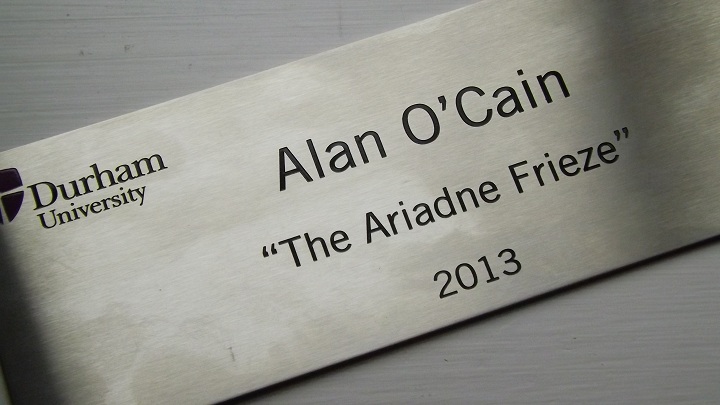
Yesterday, November 7th 2013, Ustinov College SCR and GCR kindly organised a special event to celebrate the unveiling of "The Ariadne Frieze". Steve O'Connor gave a richly Mancunian recitation of my five Haikus for Ariadne, mathematical maverick Josh Bull an entrancing version of Acker Bilk's "The Stranger on the Shore" and Ustinov's own Ola Williams brought the house down with a finale of Mariah Carey's "Hero".
I popped into the empty space of Fisher House today to take photographs of the frieze. The work is designed not only to fit the space, but also to act as an extension of the window structure above. On certain days the sun will beam through the window, making the scenario for the fall of Icarus complete. During late night social events, the frieze will be hanging in darkness, but still have a glowing presence due to a deliberate use in parts of titanium white.
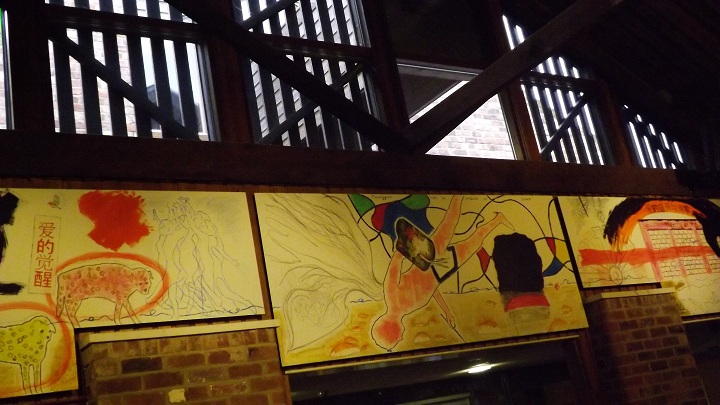
Several people have asked about the choice of aluminium for the work. I wanted to use a modern material designed specially for large hangings, one that will never stretch or warp, and one that can be made to any size or shape. Aluminium is chemically inert and surprisingly light, ideal for artwork in a public place. The panels came factory primed. Other people were keen to have a record of my words about the meaning of the frieze. We have a plan to put an audio explanation in Fisher House, accessible through headphones.
With just a few days to go before the exact 150th Anniversary of Edvard Munch's birth (December 12th) his image as a falling Icarus is in place in Ustinov College. Munch's greatest desire was to have the chance to create paintings specifically for permanent display. I am thrilled to have been given such a chance, and to have been given unwavering support by Ustinov's students, alumni and staff. Like Bacchus, god of wine, I raise a glass to the frieze and to you all.
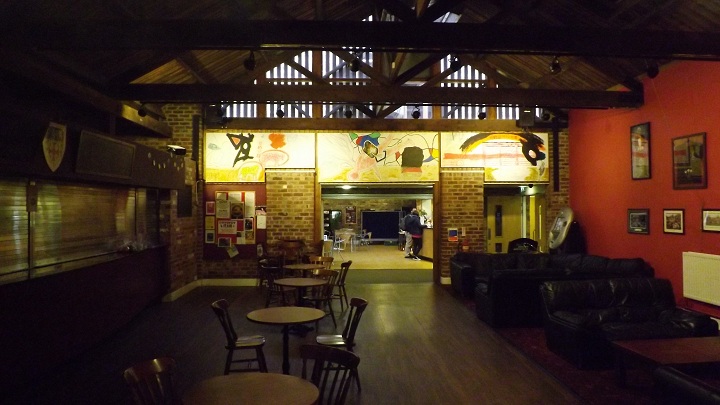
The Ariadne Frieze in Fisher House, 8 November 2013
Unforgettable Moment
7 November 2013

Bast Beach photographed earlier this year
Gaze at the photograph above and consider the ravages of time. All things must end. Today we went back to Blast Beach to see the rock stack featured in The Ariadne Frieze, a pilgrimage before the evening unveiling event; a visit to the landmark captured in the work: and the stack was not there. Instead a heap of rubble. Sometime during the previous forty-eight hours the sea had finally destroyed the edifice I'd used to symbolize the sails of the ship of Theseus. For thousands of years this outcrop had defied the rampaging seas, but in the week of coming to artistic immortality it had finally given in. We spoke to a beachcomber who'd been walking on the beach for fifteen years (finding everything under the sun, including a glass eye!). He told us that at the end of the 19th Century a whole family had lived in a lean-to by this stack. That family now long gone. Seeing that space where the stack had been sent a shiver up my spine. A shock. An unforgettable moment.
Hanging the Frieze
4 November 2013
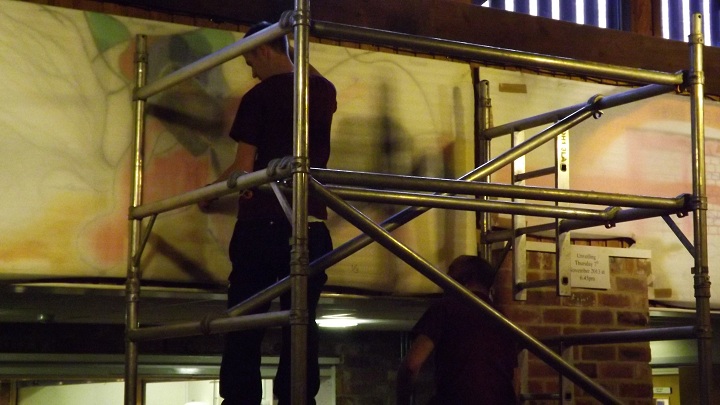
The Ariadne Frieze arrives in Fisher House
Today the wonderful Paul and Stuart arrived to hang The Ariadne Frieze in Fisher House. A complicated procedure but the guys are well used to it, having hung many works throughout the University. The panels were hooked onto special wooden batons to get initial positioning correct and then fastened in place with hidden security screws. The result is a great effect, the panels appearing to float without visible means of attachment some five centimetres from the wall. Now two days of the paintings shrouded in semi-translucent wrappings before the grand unveiling!
The Ariadne Frieze Explained
25 October 2013

Montage of the complete frieze, October 2013
The Ariadne Frieze toys with traditional notions of narrative, and can be read from left-to-right or right-to-left. Reading from the left, time moves backwards, yet the story progresses from birth and the birth of love through to abandonment and death. From right-to-left time moves forward and the narrative follows the classical story of Ariadne and also follows the path of my own life and the life of the North East region. I will begin my explanations therefore with the right-hand panel, whilst attempting to avoid too many repetitions from previous blog posts.
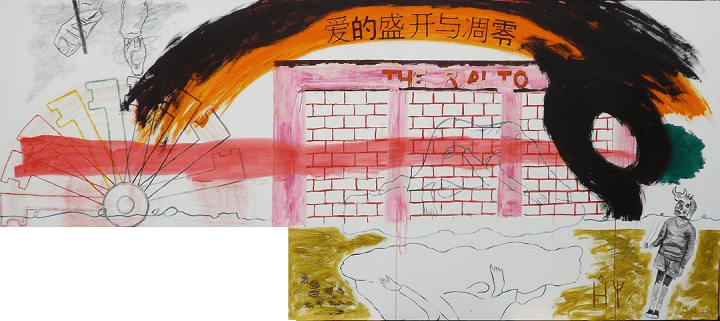
The Ariadne Frieze, right-hand panel
In the right-hand panel is the boy-Minotaur, based on a childhood photograph of myself in the 1960s, holding my sister's hand. The Minotaur was half-brother to Ariadne, and in the frieze she lies curled on a rock, a paradoxically incorrect reflection of her image in what could be a rock-pool below. She sleeps on the shores of Naxos as Theseus breaks his promise of love to her and makes an escape. I have depicted feet top left to represent the absent Theseus, and based these on a sketch I made at the Durham Miners' Gala in 2013 (of feet of a banner carrier for Seaham and Ryhope - one foot injured and encased in a support). Beneath the feet a rainbow-coloured wheel of keys infer industry or machinery - or the key to "escape", from the Labyrinth, or from a working-class life of manual toil. I have exchanged Easington Beach for Naxos, and behind Ariadne rises the bricked up exit of the abandoned Easington Rialto Cinema. Whether Easington or Naxos, we are trapped here in a place of loss. The Minotaur's head in this work is a copy of the bull featured in Picasso's masterpiece of loss "Guernica".
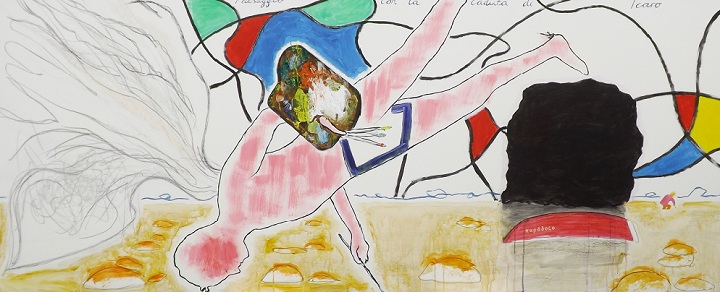
The Ariadne Frieze, centre panel
The centre panel of the frieze has been discussed in detail in previous blog posts. Here is the Norwegian painter Edvard Munch, styled as falling Icarus. A tiny figure on the beach in the backgroud is oblivious of the tragedy happening behind her. I was inspired by the 16th Century painting "Landscape with the Fall of Icarus" (contentiously attributed to Peter Breughel the Elder) in which no one notices Icarus's fall. This same title is written on my work in Italian. The scene is set on Blast Beach, Seaham and the tiny figure is based on my wife Juliet, collecting Seaham sea-glass. So, the falling artist I also see as myself, flying perhaps at times too close to the sun in the risk-taking of being an artist. Bright colours for a scene of devastation, but there is hope beyond the demise of Icarus. The black lines represent the twists of Ariadne's thread, but enclose stained-glass window hues symbolizing resurrection and hope. Dreams re-born. A coast recovered from industrial blight; a community moving towards the new.
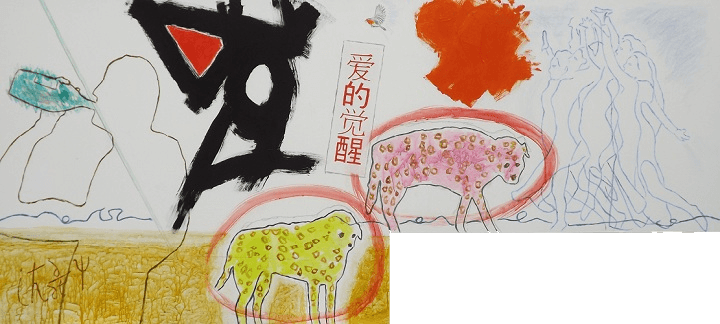
The Ariadne Frieze, left-hand panel
In the left-hand panel joy is unconfined. Ariadne has beheld beautiful Bacchus and dances towards him. He drinks from a bottle of wine. Two leopards, the conveyors of his chariot, look on. Love has been re-kindled. See previous posts for further information about the images shown here. This represents the maturing of an artist's life; a celebration of new important works. It is also a celebration of the ecologicial recovery of the North East coastal landscape. I thank Ustinov College for affording me the opportunity to encapsulate my life through these three works. And hope students, staff and all visitors to the college find comfort, hope, humour and inspiration in the narratives.
Final Brushstroke
30 September 2013
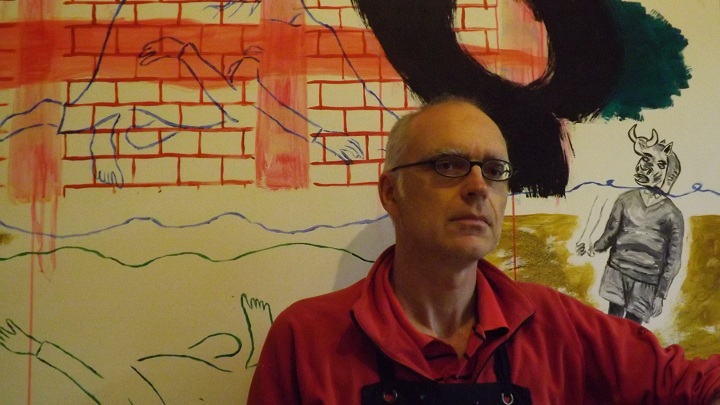
Self-portrait photograph with painted self-portrait as the boy Minotaur
5.55 pm today and The Ariadne Frieze is finished! Appropriate that the time should be all fives. The second last element I added to the work, a long horizontal slash of red across the right-hand panel, accidentally resulted in paint runs I had to leap-in and rub away, leaving two "extra" pale pink verticals to add to three deliberate ones (the pillars of The Rialto Cinema). No way to remove these extra verticals so now there are five. In numerology the number is associated with travel and motion. The extra verticals have run over a circle-of-keys in the composition I intended to to represent the movement of a colliery-head wheel, or the machinery used at one time to convey colliery waste into the sea. And the number five also represents instability, life amidst chaos and dramatic change. I have portrayed myself as the boy Minotaur, an innocent, holding the hand of his sister, unaware of the catastrophic changes ahead. So, serendipity, that friend to all expressionist artists, adds an extra element to the work and as I type this listening to the hynotic sounds of U. Srinivas and Michael Brook ("Dream") the five pale pink pillars seem just right.
Coming in next blog entry: images of complete work and discussion of the symbolism.
Science meets art
29 September 2013
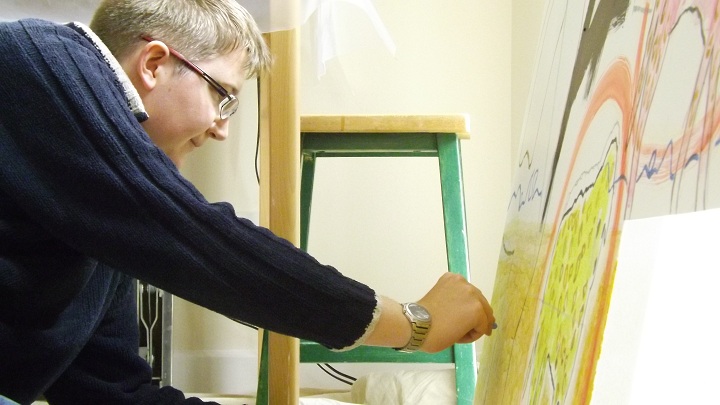
Josh Bull adds science to art
Schrödinger's Equation. The choice made by Ustinov student Josh Bull as something suitable to write on The Ariadne Frieze. The beautiful mathematical expression is rich in relevance to the work. Thanks Josh for stopping by and adding your handwritten contribution. Josh helped me to decide the shape and dimensions of the triptych at the very start of this project and I am delighted he is back at Ustinov in time to add an equation of his own choosing.
Tomorrow (September 30th 2013) I expect to complete the triptych. I have been working all day on the right-hand panel adding images ranging from a distraught Ariadne through to the closed down Rialto Cinema at Easington on the Durham coast. The day was enhanced by an engrossing chat with visiting scholar Sinkwan Cheng about all things art.
Exhausting work! (See below)
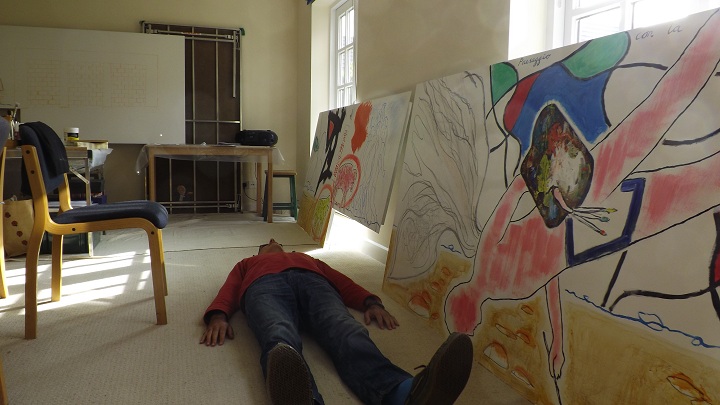
Art is 90% thinking and 10% action . . .

Panorama showing the specially shaped aluminium panels for The Ariadne Frieze
Ariadne's Dance
25 September 2013
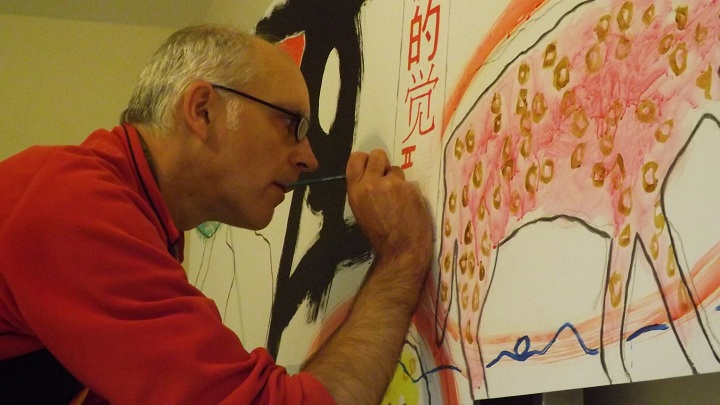
Adding Chinese Text
With the addition of Chinese text, the left-hand panel of The Ariadne Frieze is complete. Thank you to Ustinov student Tao Xue for the translations. I have cast my own shadow as Bacchus in this scene, meaning the triptych shows the life of an artist in three stages: from boy-Minotaur on the right, to falling victim in the centre, through to otherworldy bringer of joy and inspiration on the left. As a ten-year pupil at Diamond Hall Junior School in Sunderland I played the Minotaur in a theatrical production. Thankfully I was able to hide embarrassment beneath a fully-enclosing papier-mâché bull's head. What's more, a pal and I enjoyed the glorious freedom of escaping normal lessons for three full weeks in order to make the prop.
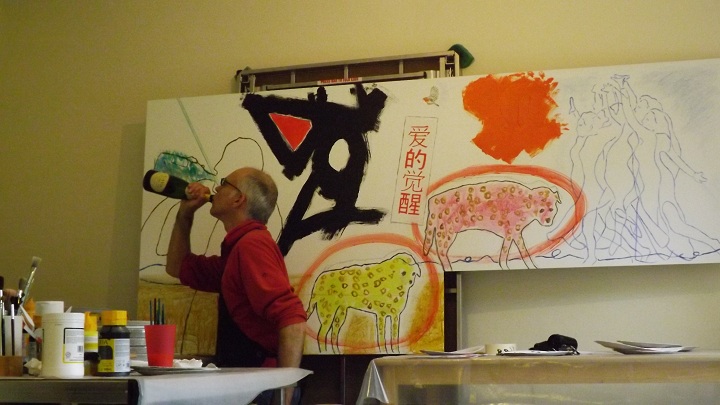
Celebrating completion of the panel (in the style of Bacchus!)
The montage of multiple dancing Ariadne figures in the panel (with a nod to Duchamp's famous "Nude Descending a Staircase, No.2") is based on a photograph-sequence of Durham PhD dance student Elena Catalano. Elena performed improvised movements to a series of haikus I composed especially for the purpose. We used the Zen garden at Durham's Teikyo Japanese University. Below are the haikus. They are based on Ariadne's despair at abandonment by Theseus mixed with exhilaration, yet uncertainty at the future she might face with dynamic Bacchus. (Below the poems is a 2-minute video of Elena's dance!)
I will come to you
Like the bee to the flower
My gift is sorrow
My hands are empty
But are filled with loneliness
You will drink from them
I need no temple
Let my brow anoint your breast
Throw my crown to sky
The tree's branch is wide
My limbs are slender and weak
I will rest here
So the gods decreed
I am a puppet, helpless
As the Spring brings thaw
A Poem of Life and Death
24 September 2013
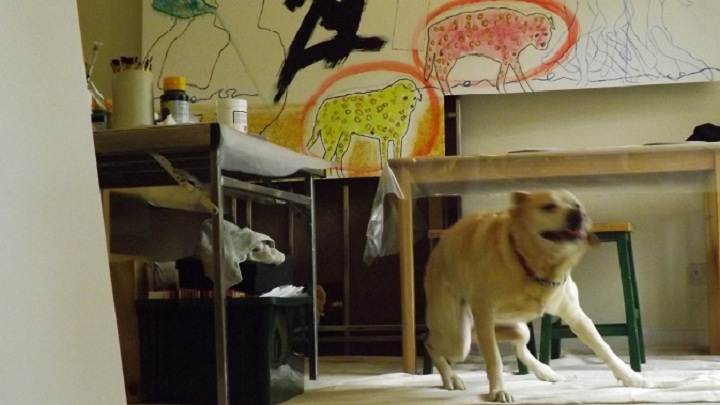
Ellie and leopards - left-hand panel of The Ariadne Frieze and the college principal's dog
Just some Chinese writing to add to the left-hand panel of The Ariadne Frieze and the work will be two-thirds complete. The writing will say "love's awakening". I have taken the title from that given by Edvard Munch to one wall of the exhibition in Berlin in 1902 of his 22-painting sequence "The Frieze of Life". Each of four walls was given a title by Munch who saw his sequence (not then called "The Frieze of Life") as a "poem of life and death". Munch's sequence traced a man's life, namely his own, and the subsequent walls featured "love blossoms and dies" (the title I will give my right-hand panel), "anxiety" and "death".
Why am I referencing Munch's sequence? And why am I using Chinese for my titles? 2013 is the 150th Anniversary of Munch's birth. To celebrate this auspicious year I have cast Munch as Icarus in the centre panel and copied Munch's common practice of setting a narrative painting in a coastal landscape (for me the County Durham coast). The work will hang in Ustinov College, a centre of international learning with a significant Chinese student population, and my artistic style is influenced by the flattened perspective, graphical character and multiple time-frame of Eastern figurative art. I also enjoy textual elements in visual art - from a variety of languages: the centre panel of my frieze is titled in Italian directly on the work "Paesaggio con la caduta di Icaro" (as a thank you to accomplished Italian dancer Elena Catalano, who kindly posed and danced as the model for Ariadne in this work).
And in contrast to Munch's sequence,The Ariadne Frieze is a poem of death and life. Deliberately designed to be read from right-to-left, my as yet unpainted right-hand panel begins with death: of the Minotaur's victims, the Minotaur himself, of the great manufacturing industries of the North East, of members of my own family, of the past and of a regional way of life. But after the fall of Icarus, and the suicide of Theseus's father love is awakened. Distraught Ariadne dances for joy at the sight of Bacchus (Dionysus) in the left-hand panel, pulled in a chariot by magnificent leopards (in my work played by college principal Maggie O'Neill's dog Ellie!). Here is happiness. And amidst it all, a robin takes flight. A symbol of song. As just such a robin sang from dusk-till-dawn at the beginning of my time here - giving unimaginable comfort throughout a certain cold, dark, long, death-haunted winter night.
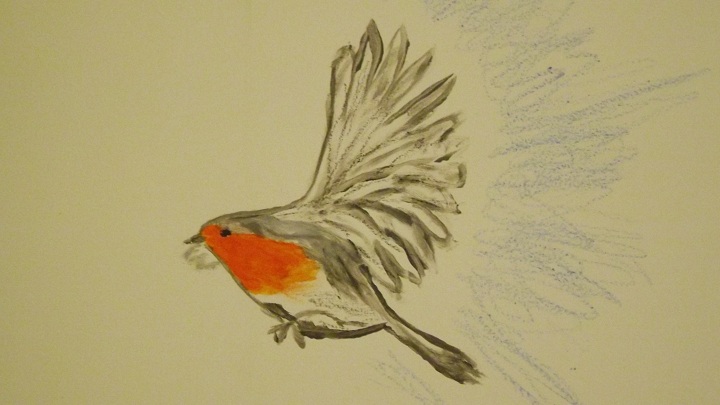
Robin in flight
Winging it - a 54 second video
21 September 2013
The Power of Music
18 September 2013
I have now completed the painting of the centre panel for the Frieze. The final stages involved adding addtional black lines and working more on the image of the palette. The work looks simple and unfinished, exactly as I intended. Simple is actually difficult. This entire composition is based on balance and contrast and the creation of depth through motif-layering. I am a figurative painter, but my primary concerns are with shape, line, mood and colour. In recent years I have been attracted more and more to creating paintings that appear like line drawings locked within complex abstract configurations. I like the colour within the abstraction to be anarchic and somewhat out of control.
The central panel is based on Blast Beach, Seaham and I deliberately wanted a cartoon-like effect in the depiction of the sand and boulders (referencing perhaps Philip Guston and Roy Lichtenstein.) This very slapdash effect requires the creation of a particular mood in the studio to achieve with any confidence. Music is a massive help: and thank you here to Miles Davis and "Miles Runs the Voodoo Down". As can be seen in the photograph below, I enjoy "colouring outside the lines". I like to create work (and look at work by others) that seems technically liberated and unintimidating; work that drives the viewer to want to rush away and snatch up a paint brush and get creating.
All hail the developments in painting from the end of the 19th Century onwards that gave credence to such freedom! My task next is to create the left and right pendant panels for the Frieze. So crank up the volume on the little ghetto-blaster I have here that was bought in New Zealand in 1998 and stand back - paint, like Daedalus winging away from his stricken son Icarus, is about to fly.
NB The title of this blog is taken from the title of one of my all-time favourite paintings by Oskar Kokoschka. (A man who knew how to fling paint about).
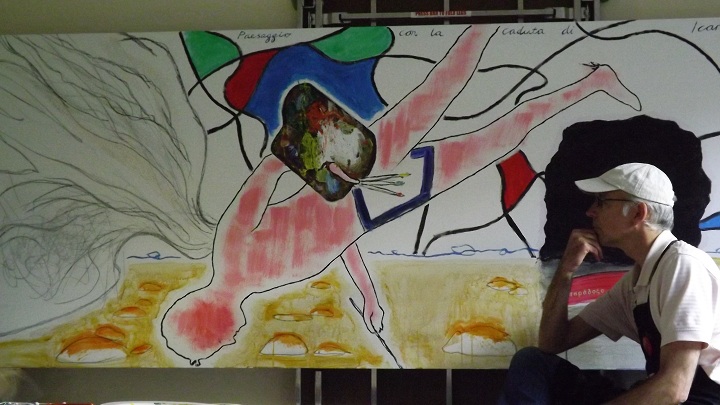
Artist and artwork - 18th September 2013
The Ship of Theseus
9 September 2013
Started adding paint to the panels today for the first time. I'm working on the centre panel, depicting Edvard Munch/Everyman/Alan O'Cain as Icarus plunging with palette in hand towards the sea. It occurred to me I've been here in residence at Keeper's Cottage, Ustinov College for nine months. Exactly the human gestation period. The idea for The Ariadne Frieze has been growing all that time, taking nourishment from the college and the regional surroundings. And Keeper's Cottage began for me in January like a comforting womb. In that snowbound month it was a haven of warmth and friendliness during an unexpected family tragedy. I'll be nearing completion of this panel on 9/11. Fitting, as I see the Icarus figure as also a reference to the shocking photograph that became known as "The Falling Man".
But humour also twists through this composition. I'm going to put a beached boat in the scene, beneath a dark coastal stack. The boat represents the ship of Theseus. (The black stack the famous black sails). I will give the boat a name, painted in Greek, but techically upside-down (as the boat is upturned): "Paradox". When Theseus returned to Athens, so it is said, his people did not want to remove his ship from the beach. Over many years it decayed, and as each section rotted, so that section was replaced. Until the entire vessel was renewed. The paradox of "The Ship of Theseus" - at what point, ancient philosophers asked, does this object cease to be the celebrated ship?

Bast Beach Panorma (photo: the artist)
Can a Symbolist be an Expressionist?
28 August 2013
The Ariadne Frieze is dripping with symbolic meaning and it could be said I'm working here very much in the "Symbolist" tradition. Symbolism flourished in France in the late 19th Century and rejected realism in favour of the use of motifs or visual metaphors conveying ideas and states of mind. Religious or mythological subject-matter was popular, as were themes of death or sin. Painters such as Puvis de Chavannes had a significant influence on artists who followed, particularly the young Edvard Munch, who despite wishing to paint works true to his own life failed to leave the power of symbolism behind.
Expressionists (as they became known), those painters, mainly German in the beginning and inspired by Van Gogh and Munch, who used art to convey personal emotion and generally working with direct and improvisational techniques, could be thought to be far removed from the careful planning and allusions of Symbolism. But someone like Munch invested personal feeling and emotion-driven brushwork into the manipulation of his symbols and motifs. So, he began often with a specific idea, but allowed the engine of his emotions to dictate the painterly act.
I am just about to rev my own expressionistic engine into action. I have a clear symbolist composition pre-planned but will use music, feeling and mood-of-moment to drive the paint across the aluminium panel surface. The finished work will be a narrative frieze of symbolic elements forged from an extensive series of spontaneous creative gestures. (Digital mock-up of the completed work hanging in Fisher House, below, courtesy of Juliet Lunn - thanks J!)
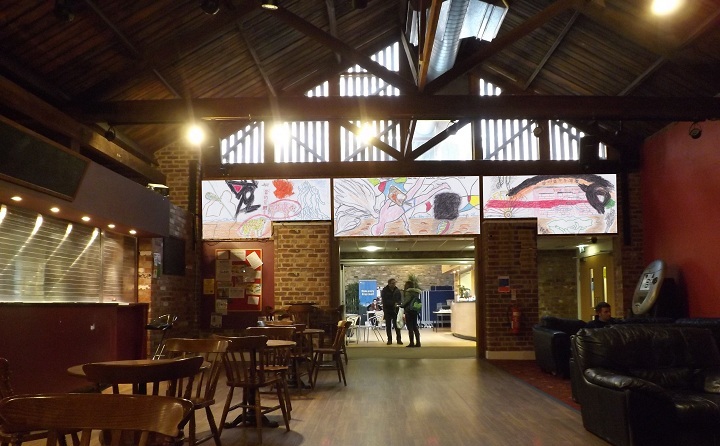
Symbolist or Expressionist artwork?(Mock-up of The Ariadne Frieze hanging in Fisher House)
From Small Acorns
16 August 2013
Whenever I create a painting I make studies first, ending with a final study (usually at 1:10 scale) and often using coloured pencil. The composition for the Ariadne Frieze first came to me as a tiny scribbled idea on a scrap of paper and has been developing in my mind and on other scraps of paper over several months. Now the final 1:10 scale study is complete. Such studies allow for the exploration of colour relationships in the work, the tonal balance and the compositional dynamic. Although the frieze is packed with symbolic elements, my overarching concern is with the abstract feel of the piece: how shapes, colours and line relate to one another and, most importantly for my personal style, how elements appear to layer up and contrast. The study is dominated by three black forms: a central lump or mass, flanked by "wings" that are a calligraphic scribble on the left and a rainbow, eyebrow or arch on the right. The colours across the work are operating in a similar way, with the palette of the flanking panels contrasting with the slightly different palette in the centre. Overall the composition is designed to capture the gaze and never let it go. The viewer then, is trapped in the labyrinth of the painting. In the picture below I am holding that very first tiny study and a montage of the triptych of 1:10 scale works is shown below that. (Symbolism to be discussed in upcoming blogs!)
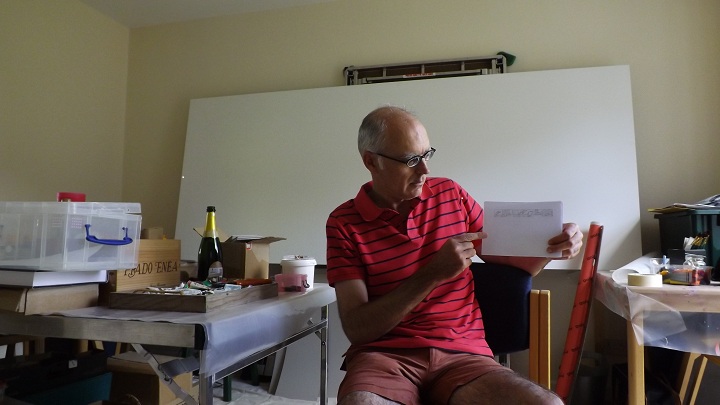
Birth of The Ariadne Frieze: first tiny pencil sketch

1:10 coloured pencil study
Landscape with the Fall of Icarus
24 July 2013
I have been planning this triptych for many months. The panels arrived at Keeper's Cottage, my temporary studio at Ustinov, in May, but only now am I set to begin applying paint. The central panel measures h112 x w277. The left and right panels are slightly narrower (h112 x w246cm and h112 x w254cm) and have sections cut-out to fit the space. The triptych will hang some 2.3m from the floor and visitors will walk beneath it whenever they pass through the building.
Appropriate therefore that the central figure in the work will be Icarus, falling from the sky. Icarus was the son of Daedalus, creator of the famous Minoan labyrinth. The labyrinth was built to house the ferocious Minotaur, half-beast/half-man, son of King Minos's wife Pasiphaë following her illicit liaison with her husband's prized sacred bull. Each year (or every seven years according to some accounts) seven girls and seven boys, taken from defeated Athens, were sacrificed to the Minotaur, cast into the unfathomable layrinth to be devoured at the monster's leisure. Theseus, son of the Athenian king Aegeus, finally defeated the Minotaur, helped by Minos's daughter Ariadne, and using a secret given to her by the labyrinth's inventor.
This led Icarus to be falling from the sky. Minos, enraged by Daedalus's actions, had imprisoned him and his son in the maze, but Daedalus was too clever to be confined. Using feathers and wax he fashioned wings to escape, warning Icarus to avoid flying too close to the sun. Boys will be boys. Icarus ignored the advice, his wax melted and he plummeted into the sea.
The figure I will use for my depiction of Icarus is somewhat unusal: a life-size outline of Norwegian artist Edvard Munch. I plan to reference a famous photograph of Munch. The photograph shows him working in 1907 on the nudist beach at Warnemünde, Germany. He wears nothing but a small apron. In one hand is a palette, in the other an outstretched brush. I will invert the figure and add wings. Why?
This figure of Munch represents all artists. It shows the dangers daring artists face: be it financial insecurity, critical derision or even creative angst. It also symbolizes the sacrifices modern-day students in all disciplines encounter, and the nerve needed to continue with challenging academic research. My Munch/Icarus figure, like Icaruses in many works from the History of Art, will be falling towards the sea. The coastline I am choosing to show is Seaham, nearest beach to Durham, namely Blast Beach, a landscape rescued from the ravages of decades of industrial desecration.
As I have been rescued from my own potential working class fate: a life of manual work (in days gone by, even perhaps in the labyrinth of a coalmine). Rescued by education, reading, art. Now in the privileged position of taking creative risks, and flying too close to the sun.
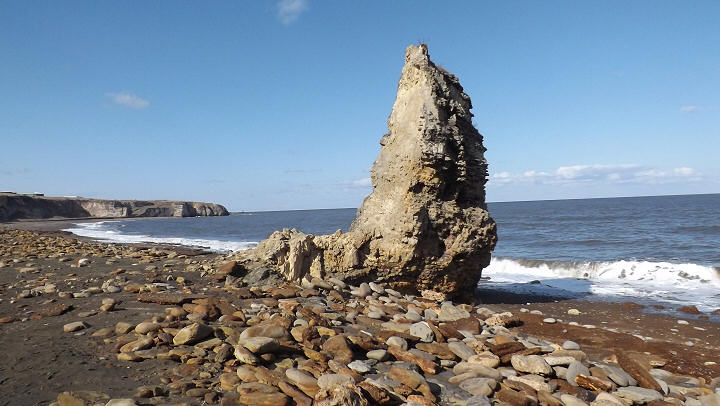
Blast Beach
"Puffin Song" by Alan O'Cain
30 March 2013
Beneath
The stack the
Red pools lap
Only when a
Fierce wind flies
In
But now the waters
Lie as still
As resting
Sump waste;
Frozen blood,
As surf
Beyond cries
Out its towering
Shriek and
Here where furnaces
Once blasted
Molten metal from
The sagging
Rocks the
Cliff-lipped
Lakes shrink
Back and leave
A rictus rim
As multi-coloured
As the puffin
Beaks on lifeless
Birds thrown
Down like wrung-
out coal sacks
On the rusted
Shore.
Thank you for visiting The Ariadne Frieze blog.